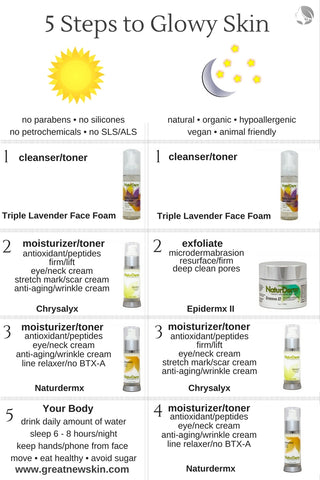You see what you eat...

Studies done by the WHO (World Health Organization) show as many as 2 billion people worldwide are deficient in micronutrients such as Vitamins A,C,E and the minerals zinc, iron and iodine. Magnesium is required for thousands of enzyme and muscle reactions and is a common deficiency, especially in women due to stress, hormonal replacement and birth control pills. The effects of just magnesium deficiency can present as high blood pressure, muscle cramps and numbness, moodiness, insomnia, cold hands, brittle nails, PMS and excema.
Phytochemicals (there are over 900) like: plant Phytosterols, Favonoids, Lipoic Acid, and Ubiquinone interplay and impact your health and skin. When you eat an apple an estimated 100 phytochemicals move into action.
Lack of necessary macro and micronutrients can be seen on the skin (face and body), as skin issues. Deficiencies can be from lack of fresh fruit and vegetable intake, poor digestion, which can include issues with digestive enzymes, food allergies, a decreased ability to eliminate toxins, and the bioavailability of the nutrient.
For example: hair loss can be associated with deficiencies of iron, biotin and zinc, excessive oil production on the nose, scaliness and redness: Vitamin B2, forehead acne: Vitamin B6, rosacea: Vitamin B2, zinc, essential fatty acids and hydrochloric acid.
The Linus Pauling Institute on Micronutrient Research for Optimum Health says, much of the role of nutrition in skin health focuses on the effects of deficiency, since the structural components of the skin are supported by a variety of nutritive factors, such as peptides, minerals and vitamins, which serve as enzyme cofactors, activators or inhibitors
Skin Nutrition depends on the interaction of 4 elements:
1). Functioning relationship between connective tissue, collagen and elastin.
2). Proper circulation in the Epidermal skin layer.
3). Hydration of cells in the Epidermal skin layer and a healthy interaction of lipids (fats) and trans-epidermal water loss (TEWL).
4). The immune response and free radical protection.
When we experience skin issues, the questions to ask are: what are you eating, are you sleeping, what are you drinking and what are you using on your skin?
Ref: A Michels, Micronutrients and Skin Health, Linus Pauling Institute/Oregon State University (Sep 2011)
www.who.int/nutrition/topics/2_background/en/index1.html#sthash.qgu0Ogxz.dpuf




















